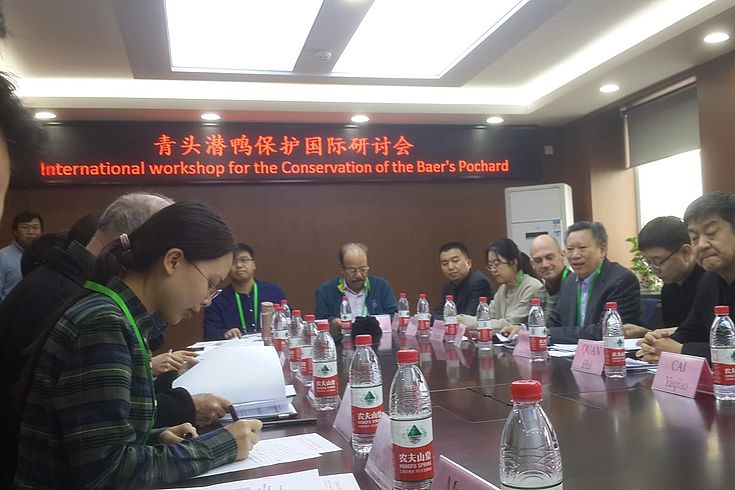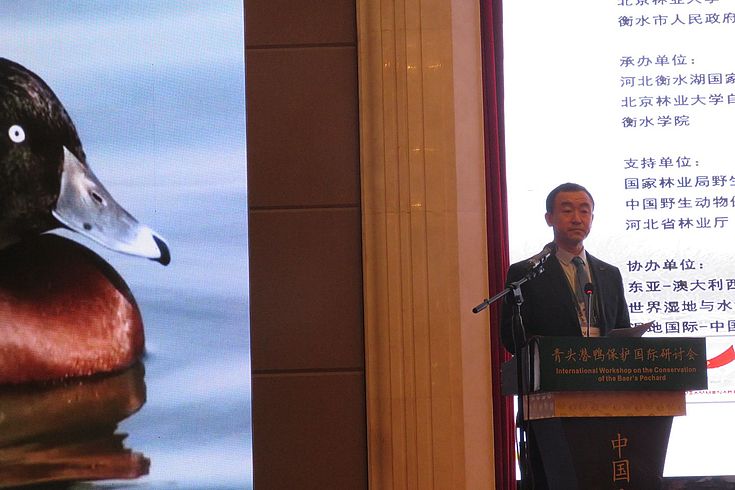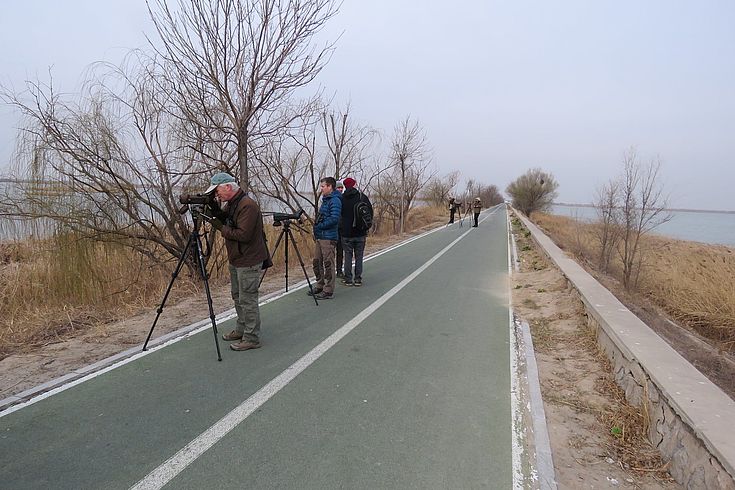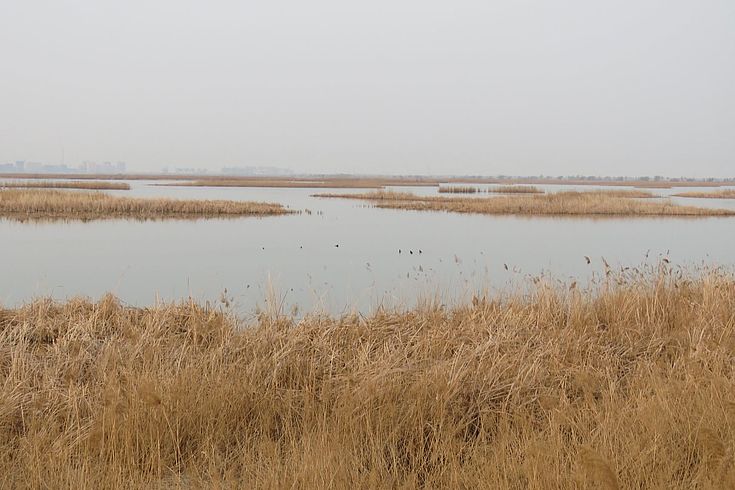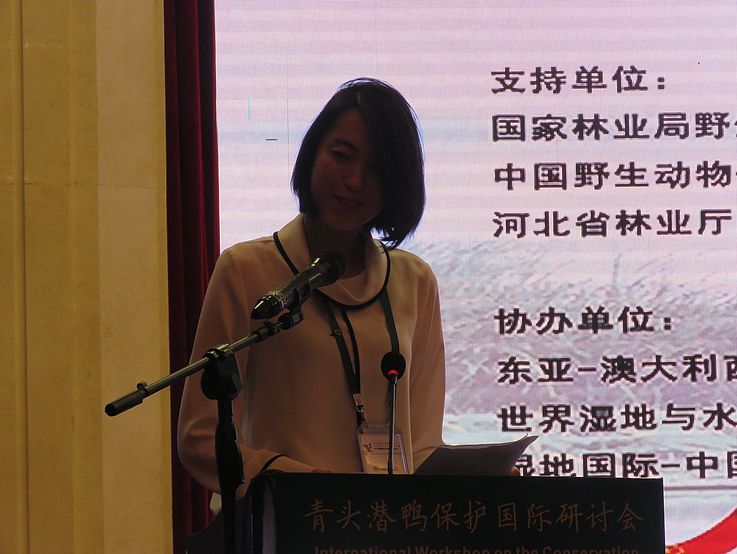Multilateral Workshop in Hengshui
Establishment of a Task Force for the Conservation of the Baer's Pochard
Premeeting of the EAAFP task force for the protection of the Bear's Pochard.
On March 18, 2018 in Beijing Forestry University the international participants of the International Workshop on the Conservation of Baer's Pochard met for a pre-meeting of the Baer's Pochard Task Force under the EAAFP, which Hanns Seidel Foundation Korea is a member of. Once numerous in the region, Baer's Pochard of all ducks living in Northeast Asia experienced the most rapid decline and is now on the brink of extinction. Under the EAAFP, a task force was founded to cope with the decline and devise strategies to conserve the species. For the first time, delegates of MoLEP of DPR Korea took part in the meeting, invited by Hanns-Seidel-Foundation Korea.
While Baer's Pochard is a regular, though now scarce, migrant on the Korean Peninsula, it might also potentially breed in the Rason Migratory Bird Reserve. This reserve recently became one of the first two Ramsar sites of North Korea under the Ramsar Convention on Wetlands. In this reserve the Hanns Seidel Foundation Korea also regularly carries out surveys and consulting work. The pre-meeting chaired by Prof. Lei Guangchun and Prof. Ding Changqing of Beijing Forestry University, which takes a lead in many protection activities in China, served to establish the objectives of the international workshop taking place at Hengshui lake. Today Hengshui lake is one of the most important remaining breeding and wintering sites of Baer's Pochard.
Opening of the Workshop by Prof. Ding Changqing, Beijing Forestry University, head of the Baer`s Pochard task force of the East Asian Australasian Flyway Partnership.
The workshop opened with several hundred participants, including members of the task force on the Baer's Pochard from China, Russia, Japan, the Democratic People`s Republic of Korea (North Korea), Myanmar, Thailand, Mongolia and India. Also numerous delegates of international organizations, among them Hanns Seidel Foundation Korea, who is a member of the East Asian Australasian Flyway Partnership dedicated to protect habitats along the East Asian Australasian migratory bird flyway. While Baer's Pochard itself is most dramatically affected by changes in habitat, human use and climatic conditions, all other species along the flyway have to cope with increased pressure on survival, too. Therefore, the protection of habitats of this species also benefits all other species of waterbirds in the area. In Hengshui, there is a strong drive by the local administration to support the conservation of Baer's Pochard, which recently became a great attraction for national and international bird watchers.
The conference started with a number of congratulatory and welcoming remarks from the region as well as international participants. The first session dealt with international studies on the status and deplorable decline of the Baer's Pochard. It started with a presentation by Richard Hearn of Wildfowl and Wetland Trust as well as Wu Lan of Beijing Forestry University. Afterwards, monitoring in the Yellow Sea area, the management of Hengshui lake and of habitat in China, conservation of waterbirds in Russia and Myanmar was discussed. The afternoon session saw further updates on the status of the Baer's Pochard in different Chinese provinces, in Mongolia, North Korea , Thailand, Bangladesh, and India. In two discussion rounds the review of monitoring and public awareness needs were discussed.
Field surveying
The next day the International Workshop on the Conservation of Baer's Pochard started in the early morning with an on-site inspection of Baer's Pochard at Hengshui lake. The lake is by now the most important site for this species threatened with extinction. Through Guido Kuchelmeister, who consults the development of the Hengshui nature reserve as part of the Sino-German Financial Cooperation project managed by KfW development bank, improvements in the management of the lake, including the closure of a dam-road going through the main lake area for cars, could be better understood. Also, several dozens of Baer's Pochards could be observed. This was particularly useful for participants of countries recording only very few animals for better understanding and identification skills of the species. Based on this newly gained insight into the species and its habitat, two concurrent sessions in the afternoon discussed habitat management and a China Action plan for Baer's Pochard conservation.
While Hengshui lake is surrounded by large urban areas with millions of inhabitants, reducing fishing, reducing human disturbance by closing roads, and restoring flat lake areas with reedbeds and aquatic plants helped preserving a unique habitat for Baer`s Pochard and other species.
The last day of the International Workshop on the Conservation of Baer's Pochard started with another field survey. This time participants looked more into the future of conservation for the rapidly declining species. In China and in particular in Hengshui, where the largest known existing population of Baer's Pochard resides, the interest in the species is now heightened, and innovative ways of protecting birds in particular during breeding and moulting will be tried out. All countries, including DPRK, agreed to put more effort in the monitoring of birds. Also, ways for better communication inside and outside the group of institutions and people interested in the bird were discussed.

